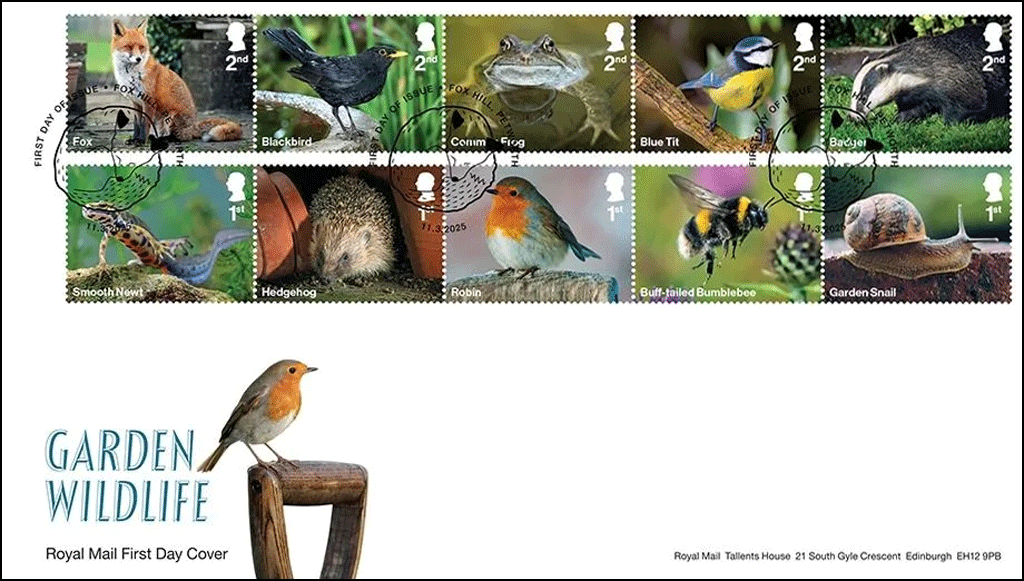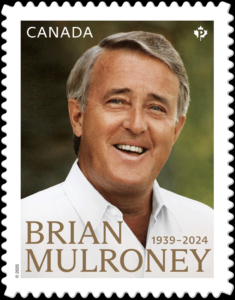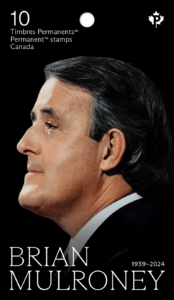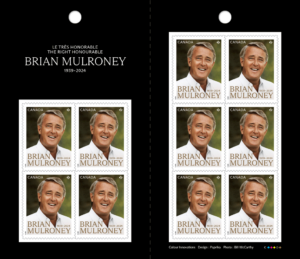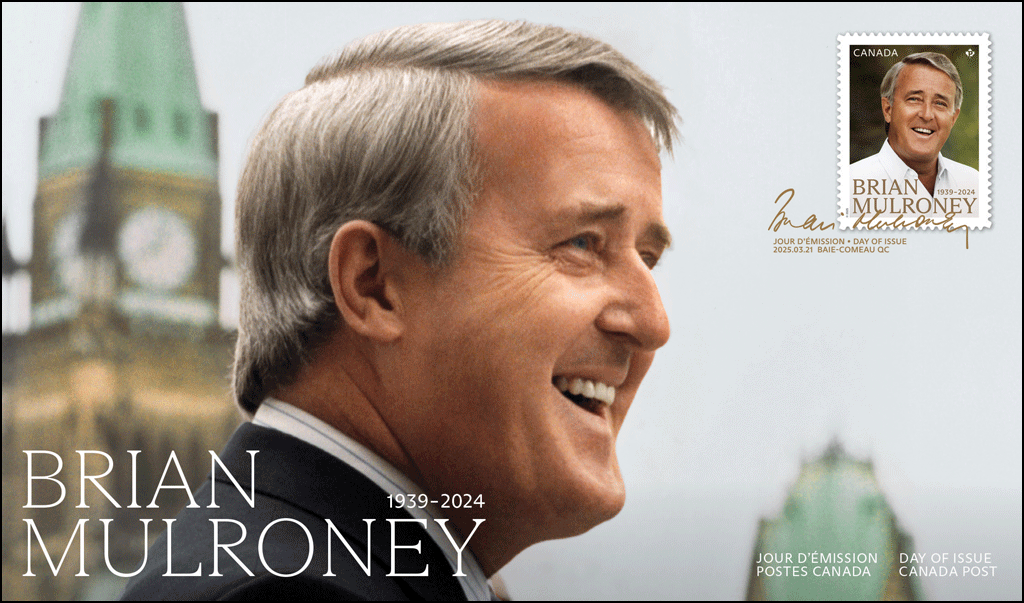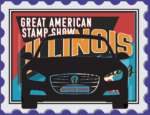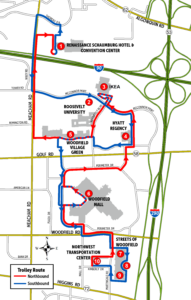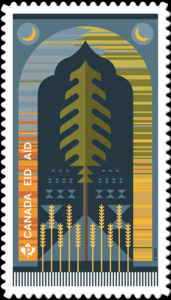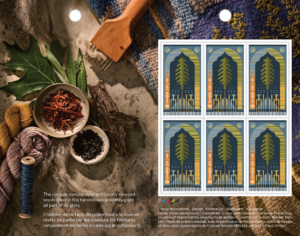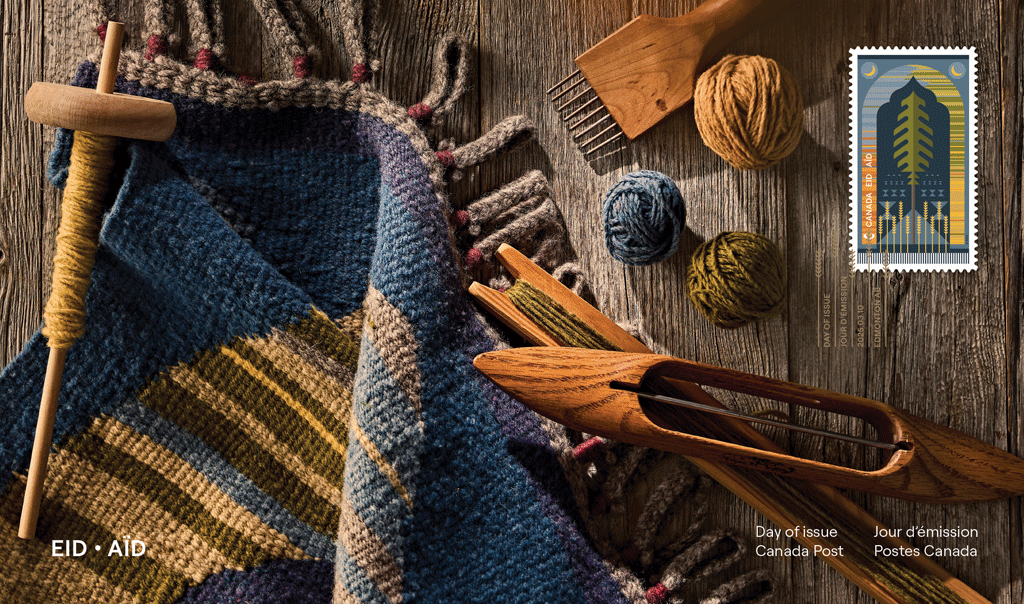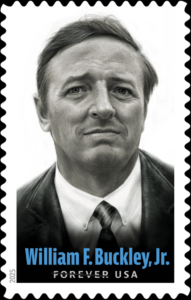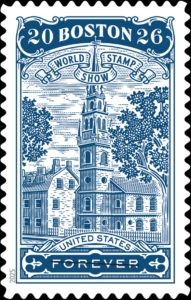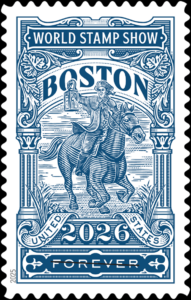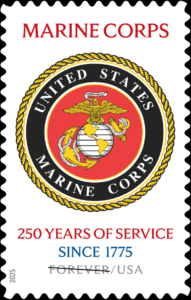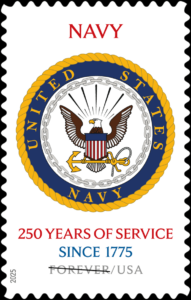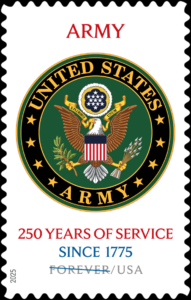[press release] [click on any of the pictures for larger versions]
Royal Mail Special Stamps Celebrate the Incredible Array of Wildlife That Inhabits Gardens Across The UK
- Issue date: 11 March
- The 10-stamp set shows striking images of wildlife that inhabits gardens of the UK
- Featured on the stamps are: a Fox; Blackbird; Common Frog; Blue Tit; Badger; Smooth Newt; Hedgehog; Robin; Buff-tailed Bumblebee; and Garden Snail
- The stamps and a range of collectible products are available at www.royalmail.com/gardenwildlife and by telephone on 03457 641641
The gardens of the UK support a huge diversity of wildlife. Today Royal Mail reveals images of 10 stamps that explore some of the species that inhabit the nation’s gardens.
The wildlife shown on the stamps are commonly seen and readily identifiable – they are also widespread and include some of our most popular species.
Featured on the stamps are: a Fox; Blackbird; Common Frog; Blue Tit; Badger; Smooth Newt; Hedgehog; Robin; Buff-tailed Bumblebee; and Garden Snail.
Royal Mail worked with Professor Dawn Scott, Executive Dean of the School of Animal, Rural and Environmental Sciences at Nottingham Trent University, on the stamp issue.
Professor Scott said: “It was fantastic to work with Royal Mail to celebrate our iconic British garden wildlife in this special collection. Gardens can provide havens for a rich diversity of wildlife, this collection highlights just a few. I hope the beautiful images inspire people to continue to support wildlife in their own gardens.”
David Gold, Director of External Affairs and Policy said: “British people are renowned for their love of gardens, and no matter how small, in urban or rural areas, wildlife can thrive there. These stamps capture the rich diversity of wildlife found in gardens across the UK, and remind us how lucky we are to live so close to nature.”
Wildlife of the UK:
Within the millions of gardens in the UK, there is a wide range of habitats, including flowerbeds, shrubs, lawns, ponds and compost bins, each providing resources to support a plethora of species.
Positive management of our gardens – such as increasing flowering-plant diversity, reducing chemical use and providing natural food resources and refuges for hibernating animals, not only benefits our wildlife but also gives us immense benefits from increasing biodiversity.
Wildlife pollinates our plants to provide us with fresh fruit and vegetables. Wildlife recycles the waste in our compost bins and eats insects to keep control of their numbers. Gardens and green spaces have also been shown to be beneficial for our physical and mental health. All that is needed is a space in which wildlife can thrive, and humans feel the benefits.
The stamps, and a range of collectible products, are available at www.royalmail.com/gardenwildlife and by telephone on 03457 641 641. A Presentation Pack including all 10 stamps is priced at £13.40. The stamps go on general sale from 11 March.
Stamp-by-Stamp
Fox
Vulpes vulpes
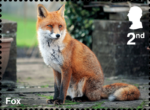 Also known as the red fox, this iconic omnivorous carnivore is widespread across the UK and commonly seen in gardens but, due to its adaptability, also occurs in many different habitats, from coasts to uplands. It has distinctive reddish-orange fur with white on the neck and belly, black on the legs and a thick, bushy tail. Foxes are generalists, having a wide diet that includes insects, fruit, small mammals and leftovers put out for them. They breed once a year, with cubs being sighted playing in gardens in early summer-
Also known as the red fox, this iconic omnivorous carnivore is widespread across the UK and commonly seen in gardens but, due to its adaptability, also occurs in many different habitats, from coasts to uplands. It has distinctive reddish-orange fur with white on the neck and belly, black on the legs and a thick, bushy tail. Foxes are generalists, having a wide diet that includes insects, fruit, small mammals and leftovers put out for them. They breed once a year, with cubs being sighted playing in gardens in early summer-
Blackbird
Turdus merula
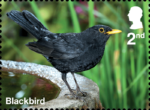 Blackbirds are found widely across the UK, from gardens to countryside, coasts to hills. They are common and easily recognisable garden visitors. The males are black with bright orange-yellow beaks and yellow eye-rings, whereas females are brown, often with spots and streaks on their breasts, and brown beaks. Blackbirds feed on a variety of insects, worms and molluscs, also eating berries and fruit when in season. They forage mostly on the ground, turning over leaf litter and probing the soil for food.
Blackbirds are found widely across the UK, from gardens to countryside, coasts to hills. They are common and easily recognisable garden visitors. The males are black with bright orange-yellow beaks and yellow eye-rings, whereas females are brown, often with spots and streaks on their breasts, and brown beaks. Blackbirds feed on a variety of insects, worms and molluscs, also eating berries and fruit when in season. They forage mostly on the ground, turning over leaf litter and probing the soil for food.
Common frog
Rana temporaria
Widespread in mainland Britain, frogs are found in damp habitats including gardens with 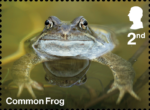 ponds. They have smooth skin – grey, olive-green and yellow-to-brown in colour – with irregular dark blotches and a dark stripe around their eyes. Frogs are mainly active at night and eat insects (using their long, sticky tongues), as well as snails, slugs and worms. In spring, males call to attract females to breed. Frogs lay large clumps of black-dotted jelly frogspawn in shallow water. Young tadpoles feed on algae, but then become carnivorous.-
ponds. They have smooth skin – grey, olive-green and yellow-to-brown in colour – with irregular dark blotches and a dark stripe around their eyes. Frogs are mainly active at night and eat insects (using their long, sticky tongues), as well as snails, slugs and worms. In spring, males call to attract females to breed. Frogs lay large clumps of black-dotted jelly frogspawn in shallow water. Young tadpoles feed on algae, but then become carnivorous.-
Blue tit
Cyanistes caeruleus
Possessing distinctive blue-and-white heads, with black eye-stripes and yellow breasts, 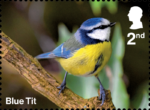 blue tits are one of our most familiar garden visitors. They are common in woodland, hedgerows, parks and gardens, feeding on insects, seeds and nuts. It is estimated that over 15 million blue tits overwinter in the UK, with numbers recently increasing, possibly due to supplementary food and bird-box provisions in gardens. They are considered strictly ‘residential’ birds, rarely moving far from where they hatch.
blue tits are one of our most familiar garden visitors. They are common in woodland, hedgerows, parks and gardens, feeding on insects, seeds and nuts. It is estimated that over 15 million blue tits overwinter in the UK, with numbers recently increasing, possibly due to supplementary food and bird-box provisions in gardens. They are considered strictly ‘residential’ birds, rarely moving far from where they hatch.
Badger
Meles meles
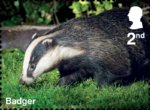 With their unique black-and-white face markings, and being the largest native land carnivores in the UK, badgers (also known as European or Eurasian badgers) are easily recognisable. They are members of the mustelid family, closely related to otters, stoats and weasels. Badgers live in groups called clans, based in underground setts. They are nocturnal, spending much of the night foraging for food. Although their diet can be wide-ranging, badgers do have a liking for earthworms and can eat over 200 in a night.-
With their unique black-and-white face markings, and being the largest native land carnivores in the UK, badgers (also known as European or Eurasian badgers) are easily recognisable. They are members of the mustelid family, closely related to otters, stoats and weasels. Badgers live in groups called clans, based in underground setts. They are nocturnal, spending much of the night foraging for food. Although their diet can be wide-ranging, badgers do have a liking for earthworms and can eat over 200 in a night.-
Smooth newt
Lissotriton vulgaris
Also known as the common newt, this species is widespread and often found in garden 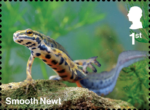 ponds or in habitats such as woodpiles and rockeries. They feed on insects, slugs and worms on land, and hunt invertebrates and frog tadpoles in the water. Both males and females are grey or brown in colour and have an orange or yellow belly with black spots that extend up to the throat. During the breeding season, males develop a wavy crest along their body and tail. Females lay their eggs individually and wrap them in aquatic plant leaves for protection.
ponds or in habitats such as woodpiles and rockeries. They feed on insects, slugs and worms on land, and hunt invertebrates and frog tadpoles in the water. Both males and females are grey or brown in colour and have an orange or yellow belly with black spots that extend up to the throat. During the breeding season, males develop a wavy crest along their body and tail. Females lay their eggs individually and wrap them in aquatic plant leaves for protection.
Hedgehog
Erinaceus europaeus
Garden visitors that have been voted Britain’s favourite mammal, hedgehogs were once 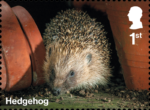 widespread across the UK in woodland, arable land, hedgerows and grassland, but have recently suffered population declines. Unmistakable in appearance, hedgehogs (also known as European hedgehogs) have several thousand spines across their backs, and pointed furry faces with small black eyes and investigative noses. Known as ‘gardeners’ friends’ due to their diet of slugs, snails, beetles and caterpillars, hedgehogs hibernate from around November to April. In gardens, this can happen in piles of leaves or logs, in compost heaps and under sheds.-
widespread across the UK in woodland, arable land, hedgerows and grassland, but have recently suffered population declines. Unmistakable in appearance, hedgehogs (also known as European hedgehogs) have several thousand spines across their backs, and pointed furry faces with small black eyes and investigative noses. Known as ‘gardeners’ friends’ due to their diet of slugs, snails, beetles and caterpillars, hedgehogs hibernate from around November to April. In gardens, this can happen in piles of leaves or logs, in compost heaps and under sheds.-
Robin
Erithacus rubecula
With their highly distinctive red breasts, contrasting with brown bodies and white 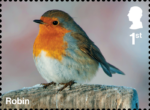 undersides, robins have been named the UK’s favourite birds. Found in a range of habitats, and common in gardens, robins are known to follow gardeners, hoovering up insects and worms that have been unearthed, although they also feed on seeds, fruits and other invertebrates. Males and females are identical in appearance. They are aggressively territorial and reinforce this by singing loudly from prominent perches.
undersides, robins have been named the UK’s favourite birds. Found in a range of habitats, and common in gardens, robins are known to follow gardeners, hoovering up insects and worms that have been unearthed, although they also feed on seeds, fruits and other invertebrates. Males and females are identical in appearance. They are aggressively territorial and reinforce this by singing loudly from prominent perches.
Buff-tailed bumblebee
Bombus terrestris
The buff-tailed bumblebee is a common and widespread species found in gardens, parks 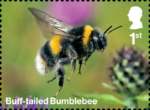 and lowland areas throughout the UK. It is a large bumblebee, with yellow bands at the collar and on the abdomen. It feeds on a wide range of flowers such as lavenders, thistles and daisy-like species where its short tongue can easily reach the available nectar. The species is named after the buff-coloured tail of the queen, although workers and males have an almost white tail, often with a narrow buff-coloured line between the black abdomen and tail.-
and lowland areas throughout the UK. It is a large bumblebee, with yellow bands at the collar and on the abdomen. It feeds on a wide range of flowers such as lavenders, thistles and daisy-like species where its short tongue can easily reach the available nectar. The species is named after the buff-coloured tail of the queen, although workers and males have an almost white tail, often with a narrow buff-coloured line between the black abdomen and tail.-
Garden snail
Cornu aspersum
Some of the most widespread garden animals, snails have pale-grey skin and brown or 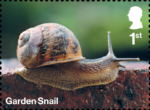 yellowish shells with pale flecking and dark spiralling bands. They are active at night, feeding on leaves, fungi and plant debris. Garden snails generally hibernate during winter. After mating, they lay around 80 white eggs in an underground nest. The newly hatched snails have fragile shells and take about two years to mature. Snails are hermaphrodites, having both female and male reproductive cells, meaning they can also reproduce by self-fertilisation.
yellowish shells with pale flecking and dark spiralling bands. They are active at night, feeding on leaves, fungi and plant debris. Garden snails generally hibernate during winter. After mating, they lay around 80 white eggs in an underground nest. The newly hatched snails have fragile shells and take about two years to mature. Snails are hermaphrodites, having both female and male reproductive cells, meaning they can also reproduce by self-fertilisation.
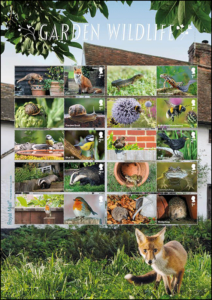 Other philatelic products for this issue include:
Other philatelic products for this issue include:
- Collectors Sheet (right) £13.70
- Postcards £4.50
- Stamp Souvenir (unpersonalised FDC) (below) £15.65
However, no personalized FDCs are offered for this issue, nor choice of postmarks.
- First-day envelope £0.30
- Full sheet of 50 1st class stamps £82.50
- Full sheet of 50 2nd class stamps £42.50
- Framed stamps £39.99

